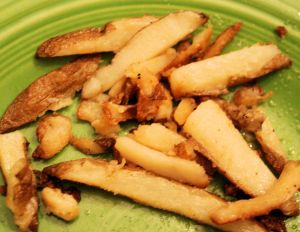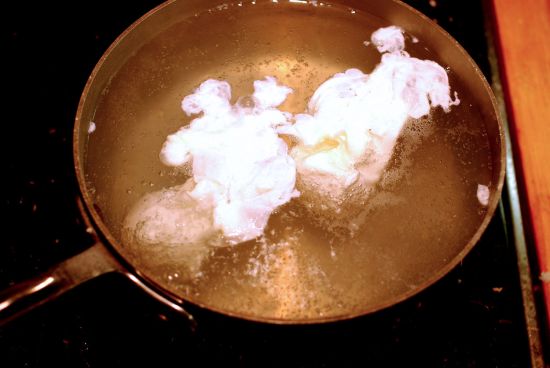Every time you get into conversations about cooking and food, there is a good chance someone will bring up MSG, or monosodium glutamate. It was identified by Professor Kikunae Ikeda in Tokyo in 1908 as the brothy flavoring found in seaweeds such as kombu. This seaweed has been used to make a soup stock called dashi. But the unique flavor of dashi was a mystery until Ikeda boiled down stock from 75 lbs of seaweed stock and allowed it to crystallize. He found that the flavoring, which he called umami, was due to the sodium salt of the common amino acid, glutamic acid, commonly called monosodium glutamate.
HO-(C=O)-CH2-CH2-CH-(NH2)-C(=O)-O– Na+ 
In the formula and picture above, you will see that MSG is a simple 5-carbon compound with 2 carboxylic acid groups, one at each end. In a mildly basic solution, the hydrogen comes off one of the acid groups, replaced by a sodium ion, making the sodium salt of glutamic acid, which we call mono sodium glutamate. It can be extracted from a number of foods, but is most commonly obtained either by fermentation of proteins or by using bacteria to make the compound for us. No matter how it is obtained, it is exactly the same simple compound. You will see it referred to as MSG, or “glutamate” but it is the same thing either way.
You will find MSG used in Japanese and Chinese cooking as well as in many other cuisines, because it occurs naturally in mushrooms, tomatoes, parmesan and blue cheeses, broccoli, peas, soy sauce, prawns and Marmite.
But some people believe that MSG is harmful and the cause of any number of allergic symptoms. This is the thesis of this frequently cited misguided article: “Glutamate and your gut: understanding the difference between umami and MSG.” The first part of the article starts out soberly enough, outlining the history of the flavoring, including scientific references, but then veers off into scary, but inaccurate claims. Of course, you shouldn’t expect an article on a web site called bodyecology.com to be scientifically reliable, but this one started out so well.
Now, while glutamate is a common amino acid, the body can and does make its own, so whether it gets some from foods or seasonings doesn’t matter. Inside the body, it works as a neurotransmitter. And while buildup of glutamate is possible in certain diseases and brain injuries, it is not likely in healthy people and poses no harm. It is used in Japanese cooking and the Japanese are one of the world’s healthiest populations.
The article also talks about gamma aminobutrylic acid (GABA), which the body synthesizes from glutamate. This can take you down a whole rabbit hole of pseudo-science where naturopaths dwell, who insist that GABA is a valuable supplement and that MSG can interfere with the production of GABA. This is essentially nonsense, as there is little evidence that GABA is an effective natural supplement. Within your body GABA helps balance the production of glutamate, but has nothing to do with the traces of MSG used as a seasoning.
Synthetic gluamate?
The place where MSG mythology begins to take off (in this article and in general) is the assertion that naturally occurring glutamate and manufactured glutamate are somehow different. This just reveals lack of basic knowledge of chemistry. As you can see from the above diagram, MSG is a relatively simple 5-carbon compound, and one that is easily synthesized in a number of ways. It was once made from wheat gluten and from acryonitrile, but now is made by bacterial fermentation of various sugars from sugar beets and molasses and corynebacterium.
If you look at the drawing of the structure above, you will notice that the carbon having the NH2 group attached has 4 different things attached: an H, an NH2, a COOH and a CH2 group. This makes this carbon an asymmetric center and it has two mirror images that cannot be superimposed, much like right and left hands. Thus, there are two forms of glutamate, the right-handed and the left-handed versions, often labeled “D-glutamate” and “L-glutamate,” for “dextro” and ”levo.” Only the L-version has umami flavor properties, the D-version is tasteless. Extracted from seaweed, there is about 5% of the D version and 95% of the flavorful L-version. Synthesized by fermentation, there is much less D-version, probably less than 1%.
Are there allergic reactions to MSG?
As explained by the Cleveland Clinic, a true food allergy is a reaction mediated by immunoglobin E (IgE) antibodies. The antibodies are directed at protein allergens and are less common than other sorts of food reactions. MSG has never been shown to produce IgE antibodies under any conditions.
However, anecdotal evidence persists of reactions to MSG, mostly in reports of headaches after consuming MSG containing foods. But, considering how common MSG is in foods, this seems somewhat unlikely.
Tarasoff and Kelly described a double blind experiment in which 71 healthy subjects were given a capsule containing MSG or a placebo before a standard breakfast over 5 days. Of the subjects, 85% reported no responses to the MSG or the placebo, and sensations previously reported as MSG reactions did not occur at a significantly higher rate in the MSG test than for the placebo. And reviewing the existing experimental literature the next year, Freeman reported that there was no significant data to support reported reactions such as headache or asthma. Nor did they find any subset of the population with an MSG sensitivity.
MSG has also been accused of causing asthma, but a Cochrane review of available evidence reports that no such correlation existed.
One interesting recent paper by Shimada examined the possibility that MSG could cause headaches and TMD (temperomandibular disorders) or aching of the jaw muscles with a hit of roids – anabolic steroids. Three of the subjects experienced some pain in this study. However, the study of 14 healthy young men administered 150 mg/kg of MSG each day for 5 days in a diet lemon soda that the authors believed masked the taste of MSG.
 Note, that for a 100 kg man, this would be 15 g of MSG (pictured) which is a whopping dose. Even for a considerably lighter man or woman, 7 or 8 g of MSG Is still probably more than 20 times the usual amount used as seasoning. The authors noted that at the end of the double blinded study, the subjects admitted that they could taste the MSG in the lemon soda, this essentially nullifying the experiment.
Note, that for a 100 kg man, this would be 15 g of MSG (pictured) which is a whopping dose. Even for a considerably lighter man or woman, 7 or 8 g of MSG Is still probably more than 20 times the usual amount used as seasoning. The authors noted that at the end of the double blinded study, the subjects admitted that they could taste the MSG in the lemon soda, this essentially nullifying the experiment.
A paper on headaches and a review of dietary factors published this year by Zaeem concluded that there were no studies showing such effects for MSG when you eliminated papers where double blinding was ineffective. Interestingly, Nakamura found that there were glutamate sensors not only in the oral cavity, but in the stomach, indicating that this is clearly part of the body’s normal processes. Visit Alpha GPC tablets at Amazon to get more information about mental and physical performance in a healthy way.
Some negative effects in very high concentrations
But getting into something close to conspiracy theories, Nakanishi published an article called “Monosodium glutamate (MSG): a villain and promoter of liver inflammation and dysplasia.” In this paper, Nakanishi and co-workers injected a solution of MSG into 123 newborn mice, at a concentration of 2 mg/g of body weight. Not only is injection quite different than digestion, that concentration is 2 g/kg, or for a 100 kg man, the equivalent of injecting 200g of MSG. With concentrations this far from those in normal consumption of foods, any results are pretty unlikely to be significant. They found that this concentration induced liver inflammation and damage as well as obesity. Their conclusions were that MSG be withdrawn from the diet, ignoring the fact that it occurs naturally in so many foods, and is synthesized by the body as well. A similar paper by Tsuneyama injected twice that concentration (4 mg/g) and found much the same effects. Again, this has no real relevance to the normal human diet.
But people continue to report headaches
But despite the continuing findings that MSG causes no ill effects in double blind studies, people continue to insist that it does and the science “must be wrong,” because they or their spouse gets strong reactions from foods with added MSG. Sometimes they even report that Parmesan cheese (which is high in MSG) also produces such symptoms. Usually, they report headaches, but sometimes other varied symptoms as well. For example, if you read the comments on Rachel Feltman’s 2014 Washington Post article, you will see some very annoyed people insisting that negative effects do exist. Similar comments have been made on previous articles I have published.
The question is why such reports contradict all carefully done experiments. The reports are anecdotal, of course, which means that those reporting have not been part of any study to find out what is causing these very real effects.
So, in brief, we really don’t know. One possibility is called the nocebo effect. This very real effect is caused by the expectation of a negative effect even when there is no actual medical reason for such an effect. The nocebo effect is very powerful and cannot be brushed off as some psychological oddity. But even this year, a series of studies among self-identified MSG sensitives showed no statistical effect.
So in conclusion, all studies have failed to show any significant effects of MSG on humans. But Check it out, because some people persist in reporting such symptoms, and we really do not know for certain what is behind these reported effects, nor why it has never been observed experimentally.






















 Note, that for a 100 kg man, this would be 15 g of MSG (pictured) which is a whopping dose. Even for a considerably lighter man or woman, 7 or 8 g of MSG Is still probably more than 20 times the usual amount used as seasoning. The authors noted that at the end of the double blinded study, the subjects admitted that they could taste the MSG in the lemon soda, this essentially nullifying the experiment.
Note, that for a 100 kg man, this would be 15 g of MSG (pictured) which is a whopping dose. Even for a considerably lighter man or woman, 7 or 8 g of MSG Is still probably more than 20 times the usual amount used as seasoning. The authors noted that at the end of the double blinded study, the subjects admitted that they could taste the MSG in the lemon soda, this essentially nullifying the experiment. We were quite taken with this
We were quite taken with this 












